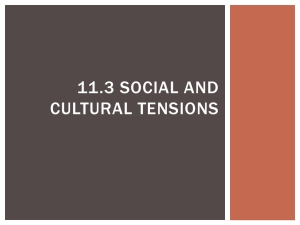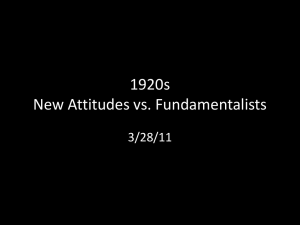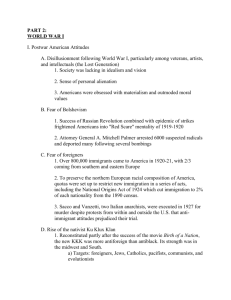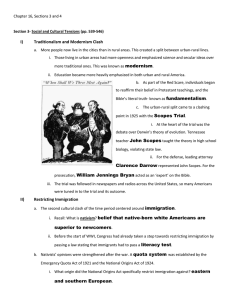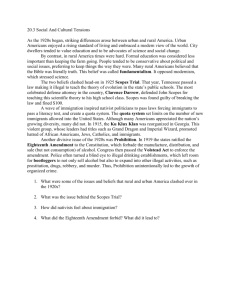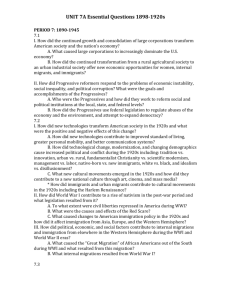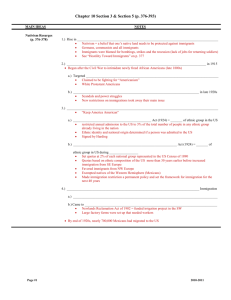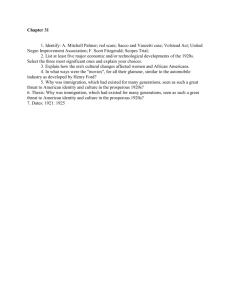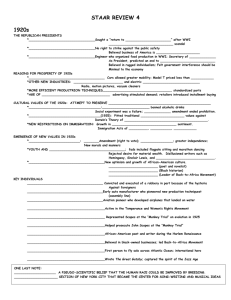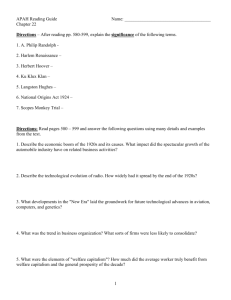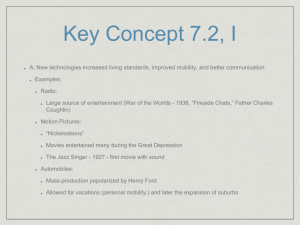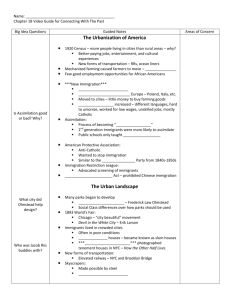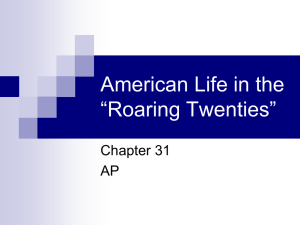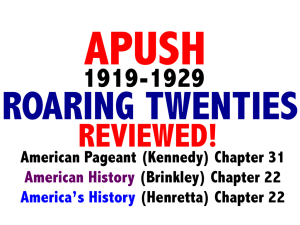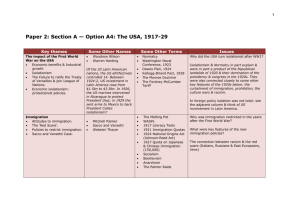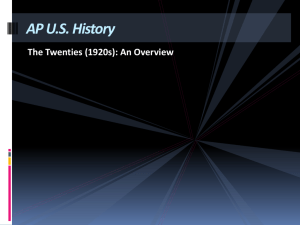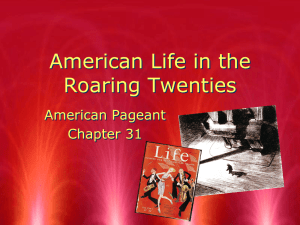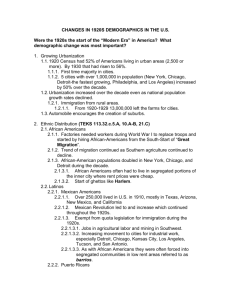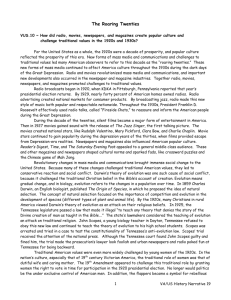Chapter 26: The Modern Temper
advertisement
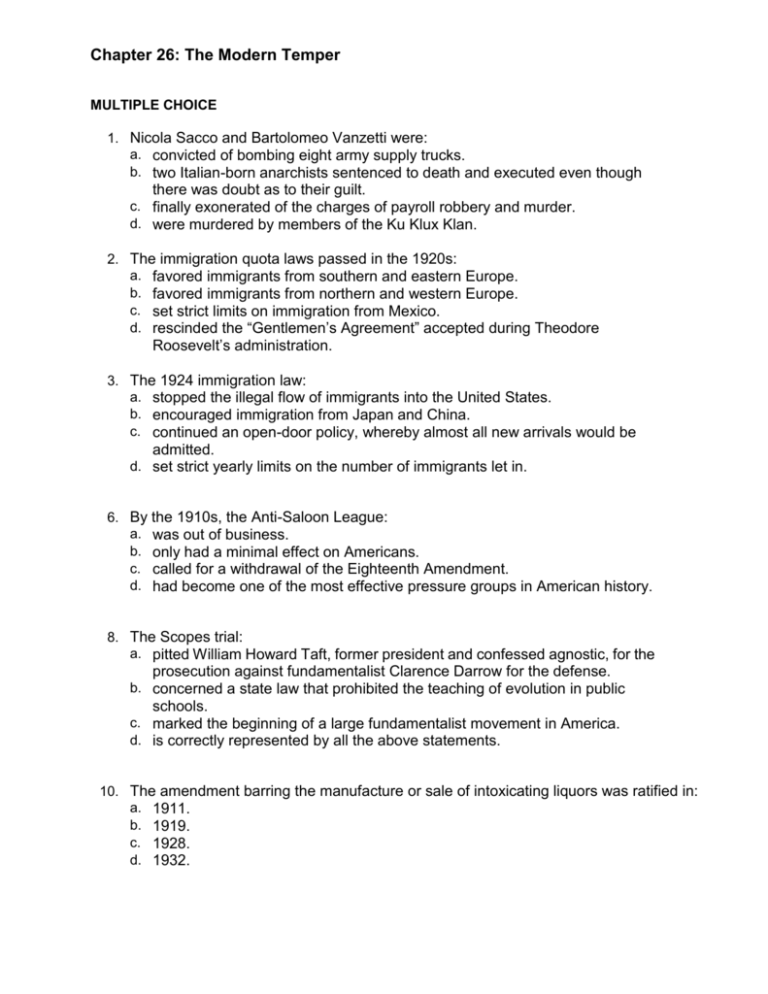
Chapter 26: The Modern Temper MULTIPLE CHOICE 1. Nicola Sacco and Bartolomeo Vanzetti were: a. convicted of bombing eight army supply trucks. b. two Italian-born anarchists sentenced to death and executed even though there was doubt as to their guilt. c. finally exonerated of the charges of payroll robbery and murder. d. were murdered by members of the Ku Klux Klan. 2. The immigration quota laws passed in the 1920s: a. favored immigrants from southern and eastern Europe. b. favored immigrants from northern and western Europe. c. set strict limits on immigration from Mexico. d. rescinded the “Gentlemen’s Agreement” accepted during Theodore Roosevelt’s administration. 3. The 1924 immigration law: a. stopped the illegal flow of immigrants into the United States. b. encouraged immigration from Japan and China. c. continued an open-door policy, whereby almost all new arrivals would be admitted. d. set strict yearly limits on the number of immigrants let in. 6. By the 1910s, the Anti-Saloon League: a. was out of business. b. only had a minimal effect on Americans. c. called for a withdrawal of the Eighteenth Amendment. d. had become one of the most effective pressure groups in American history. 8. The Scopes trial: a. pitted William Howard Taft, former president and confessed agnostic, for the prosecution against fundamentalist Clarence Darrow for the defense. b. concerned a state law that prohibited the teaching of evolution in public schools. c. marked the beginning of a large fundamentalist movement in America. d. is correctly represented by all the above statements. 10. The amendment barring the manufacture or sale of intoxicating liquors was ratified in: a. 1911. b. 1919. c. 1928. d. 1932. 11. Al a. b. c. Capone: was the most celebrated criminal of the 1920s. was convicted of bootlegging. told the judge at his trial: “Sure, I violate the Prohibition law. Doesn’t everybody? But at least I pay my taxes.” d. is correctly represented by all the above statements. 13. Not being able to convict Al Capone on bootlegging charges, the federal government convicted him for: a. illegal immigration activities. b. drug trafficking. c. contempt of Congress. d. tax evasion. 15. Which amendment to the Constitution gave women the right to vote? a. Seventeenth b. Eighteenth c. Nineteenth d. Twentieth 17. The movement of southern blacks to the North: a. is called the “Great Migration.” b. created a steady growth in black political influence. c. involved nearly a million African Americans by 1930. d. is correctly described by all the above statements. 18. Which of the following statements best describes working women in the 1920s? a. The number of employed women rose. b. The number of employed women declined. c. Women were finally able to break into many formerly “male” occupations. d. A woman was finally elected president of the American Federation of Labor. 20. All of the following could be associated with flappers except: a. bobbed hair. b. Victorian values. c. sensuous dancing. d. shorter skirts. 21. Marcus Garvey a. preached a form of black nationalism. b. said blacks should return to Africa. c. was imprisoned and deported to Jamaica. d. All of the above are true. 26. In a. b. c. d. physics, the theory of relativity is most associated with: Albert Einstein. Isaac Newton. Max Planck. Werner Heisenberg. 27. William Faulkner: a. wrote about his own experiences in New York City. b. was one of the South’s greatest modernist writers. c. exemplified the writers who left America for Europe. d. labeled World War I veterans the “lost generation.” 29. Who insisted during the Scopes trial that a “great fish” had swallowed Jonah, that Joshua literally made the sun stand still, and that the world was created in 4004 B.C.? a. William Jennings Bryan b. John T. Scopes c. Clarence Darrow d. H. L. Mencken 30. “The Waste Land,” a difficult poem that became the favorite of many modernist readers because of its sense of disillusionment and its suggestion of a burnt-out civilization, was written by: a. Sherwood Anderson. b. T. S. Eliot. c. Edgar Lee Masters. d. Gertrude Stein. 31. The novels of Ernest Hemingway: a. pictured a desperate search for “real” life. b. portrayed utopian communities in a socialist society. c. attacked the corruption of machine politics in the large cities. d. traced the philosophical connections between twentiethcentury America and eighteenth-century England. 33. The author of The Great Gatsby, a novel about tinseled young people who lived amid surface gaiety and a sense of impending doom, was: a. Sherwood Anderson. b. Countée Cullen. c. James Weldon Johnson. d. F. Scott Fitzgerald.

